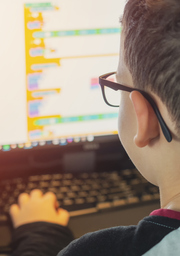Block Programming and Developing Computational Thinking
Faced with the new multidisciplinary challenges posed by the Information Society, education must continue to act as a guide so that children and young people can manage in an increasingly complex environment. And it is in this context where computational thinking, driven by the development of new digital tools, has become the backbone for the acquisition of valuable skills.
Therefore, today we want to make a practical approach to this concept through block programming, as it is an ideal option to develop some of these skills. This includes elements such as creativity or communication of ideas. It is also an enjoyable way for students to learn difficult concepts.
Block programming, from theory to practice in computational thinking
To facilitate the learning of computational thinking at an early age, it is advisable to develop its theoretical concepts through didactic activities. These serve to reinforce what has already been learned. ProFuturo’s resource ‘Introduction to block programming’ has been created and designed so that teachers can explore with their students the practical applications of this problem-solving methodology.
Starting from the base, programming is an instrumental competence that is linked to the cognitive ability that is computational thinking. For its development, codes are used that, correctly structured and organized, give rise to applications that have the ability to execute commands and carry out tasks.
However, these codes are written in specific complex languages that are difficult to assimilate. This is true especially in primary education, although fortunately we have the block methodology to iron out these edges.
The practical and fun solution to first steps in programming
Block programming compacts codes into logical and ordered sequences of instructions (blocks). It involves creating figures that represent individual events or functions. These figures possess the graphical capability to connect with each other, forming one or more logical sequences of actions. Consequently, this process results in the development of simple programs.
In this way, this methodology allows to handle, in a tangible and practical way, something as abstract as code. It does it through fun and entertaining exercises that encourage further discovery.
This is something that students appreciate, because through this simple learning process they can see in real time the results of their work. It allows them to evaluate the incorporation of new parameters. And for teachers, even in cases where they have little or no skills in the subject, they can easily assimilate the concepts of basic programming involved in this solution, as well as the core area of computational thinking that is explored with it.
ProFuturo’s lock training proposal consists of:
In its commitment to innovation and development processes in teaching, ProFuturo makes the resource ‘Introduction to block programming’ available to teachers.
Here are some of its key features that makes this unit unique:
It has been designed using the visual block language Scratch. This is specifically designed for children to learn to how to programme.
It also makes a small approximation to other options available in the market, such as Pocket Code and Blockly.
Its contents are aimed at students between the ages of 8 and 12, who have experience in the use of computers. These students also possess a basic knowledge of computer language, logical thinking and the use of programming in playful environments.
Its development is progressive. It progresses step by step, from the basics to the approach of a final challenge. Students can put into practice everything they have learned about block programming through Scratch.
It provides the fundamental concepts of block programming from a fully creative approach. It invites children and young people to make the animation of a character and encourages them to share their ideas using this simple language.
It generates memorable and fun experiences, which are a constant motivation to adequately face the resolution of problems that arise in class.
Not only does the training provide specific skills, it also sets goals to achieve transversal competencies that are basic for the personal and human development of the students.
In short, the unit ‘Introduction to block programming’ allows to take a step further in learning the keys to computational thinking. Its great advantage is that it simplifies the most complex programming concepts and frames them in a visual and attractive context, so that children feel stimulated when developing their skills.
Learning about Programming: The Complete Guide For Beginners





